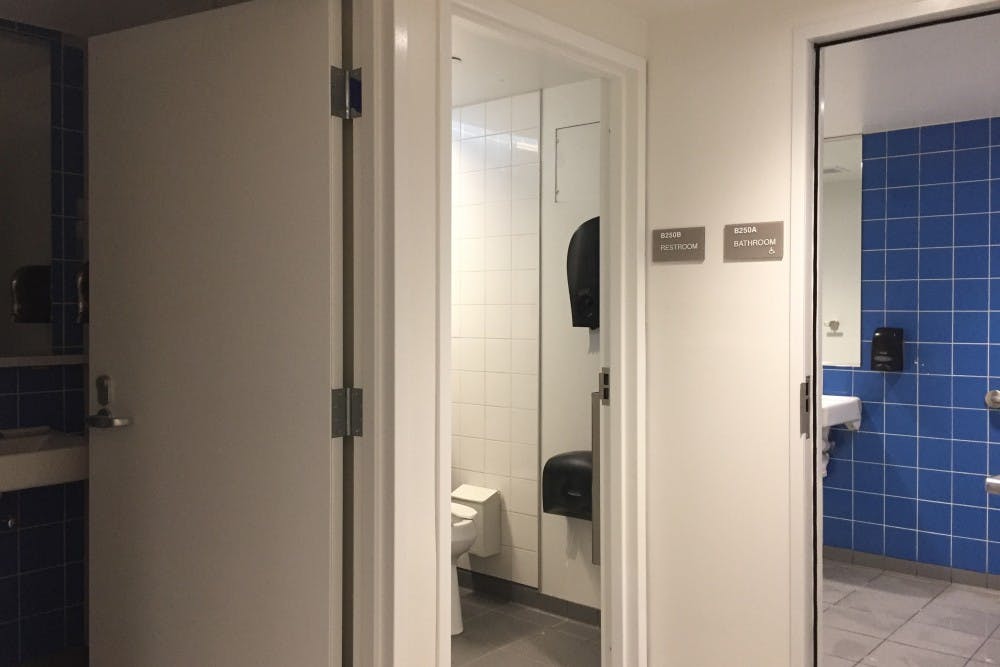
Hill College House was the first project that brought about multi-stalled, gender-neutral bathrooms for residential spaces.
Credit: Joy LeeJust under 20 percent of non-residential campus buildings contain at least one gender-neutral bathroom, but a recent push by Facilities and Real Estate Services and the LGBT Center is looking to increase that number.
After FRES recently determined that more than 100 single-stall restrooms on campus met the criteria set by LGBT Center Director Erin Cross, the team got to work converting the bathrooms from single-gender to gender-neutral.
As of this past June, 37 of the approximately 200 nonresidential buildings maintained by FRES include at least one gender-neutral bathroom, though some buildings may include up to 10.
FRES maintains 218 buildings on campus, including 18 buildings for student housing. When counting the total number of gender-neutral bathrooms, FRES does not include bathrooms in college houses because those bathrooms are designated as gender-neutral depending on student preferences each year, according to a statement from the Office of the University Architect.
Still, some students have identified problems with gender-neutral bathrooms currently on campus, noting that many are not conveniently located and some are not even accessible.
College sophomore Amber Auslander (who uses they/them pronouns) said that in Stiteler Hall, there is a bathroom designated for gender non-conforming students, but students must obtain access to the door code in order to unlock it.
“It had a code that you need to get in and the code was only recently given to Erin [Cross]. You just had to find out what it was by word of mouth,” Amber said.
Cross said the LGBT Center struggles to determine how to distribute the door code information. Some students who are not on the center's listserv or don't feel comfortable requesting the door code information are often unable to access the gender-neutral bathrooms — especially burdensome for students who are not open about their gender and/or sexual identities.
Auslander said there are also problems with other bathrooms that are not in convenient locations for gender non-conforming students, which they said leads them to “jump through three different hoops get to it.”
To address this issue, University Architect David Hollenberg said that Penn is planning to renovate bathrooms in academic buildings to be more inclusive of transgender and gender non-conforming students.

As of May, there were close to 91 gender-neutral restrooms in non-residential buildings on campus.
“The current push it to go beyond that,” Hollenberg said. “And to create multi-stalled, gender neutral bathrooms.”
Penn's peer schools have made increasing access to gender-neutral bathrooms a continuing priority. In June, Yale University sued the state of Connecticut over its state building code, which prohibits the school from making all single-occupant restrooms gender-neutral in the law school. Brown University, too, has made strides toward having bathrooms be "gender inclusive."
On campus, the renovation of Hill College House was the first project that brought about multi-stalled, gender-neutral bathrooms for residential spaces.
In six weeks, Hollenberg said “feasibility studies” will hopefully be realized once a number of academic buildings express interest in installing gender-neutral bathrooms in their buildings.
Hollenberg hopes to hire an architect who specializes in this field by the end of the semester to renovate single-stall bathrooms into multi-stall bathrooms.
“That is the next frontier,” Hollenberg said. “I’m excited about it. There’s a lot of interest in it and there’s a lot of support from Office of the Provost. They are eager for me to pull the trigger on this pilot study.”
The Daily Pennsylvanian is an independent, student-run newspaper. Please consider making a donation to support the coverage that shapes the University. Your generosity ensures a future of strong journalism at Penn.
Donate



